Microsoft Surface 2 Review
by Anand Lal Shimpi on October 21, 2013 12:00 AM ESTThe New Display
Microsoft spent a lot of time defending its decision to use a 1366 x 768 panel in the original Surface RT, all the while knowing its successor would move to the same 1080p panel as its bigger brother. With Surface 2 Microsoft thankfully embraces the importance of relatively high resolution displays in tablets. The 10.6-inch 1920 x 1080 display weighs in at just over 207 pixels per inch, which isn’t too far off rMBP standards although still shy of the iPad with Retina Display. A higher resolution panel isn’t absolutely necessary here, and given the 64-bit memory interface of Tegra 4 (and its associated GPU power) I don’t know that we’d want something substantially higher in Surface 2.
By default Surface 2 ships with 150% DPI scaling enabled, and for the most part it works well in the limited selection of classic desktop apps that ship on the machine. Since you can’t install third party classic desktop apps there’s no real chance for anything to go wrong on the DPI scaling front.
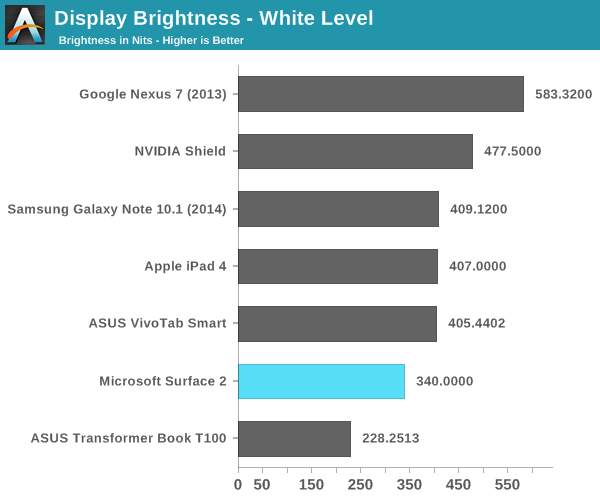
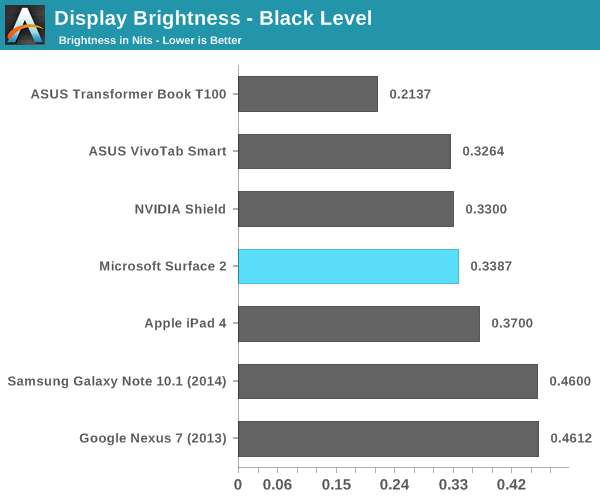
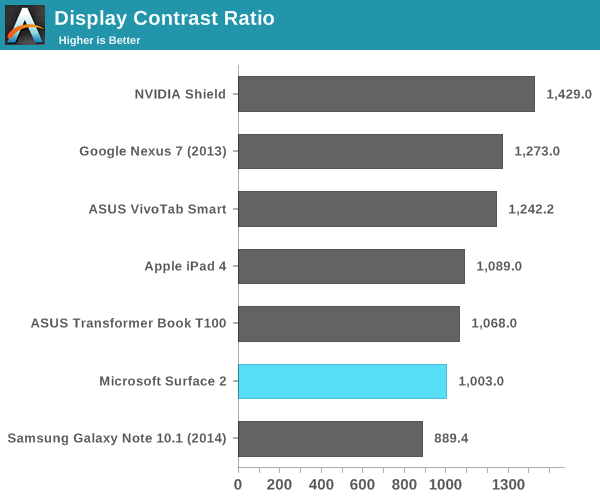
Color accuracy is much improved compared to Surface/Surface Pro. Microsoft openly admitted to not targeting full sRGB coverage at the Surface 2 launch event, which means that you’re not going to see Surface 2’s color accuracy equal that of the Nexus 7 or iPad with Retina Display. Subjectively the display looks very good, a huge improvement over last year’s model.
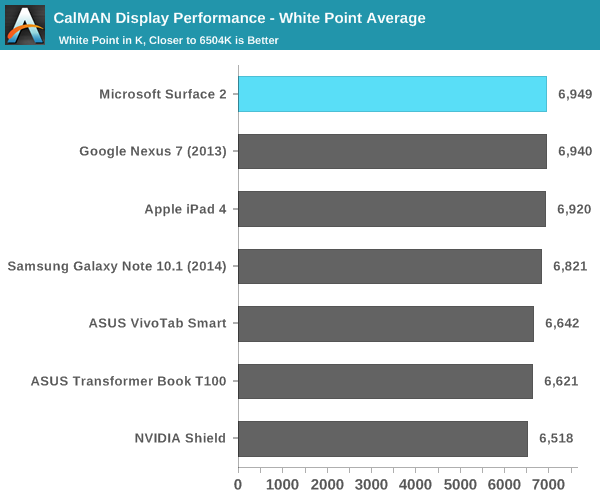
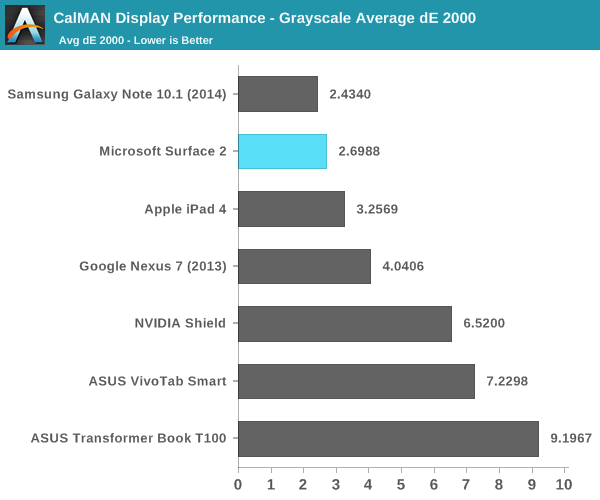
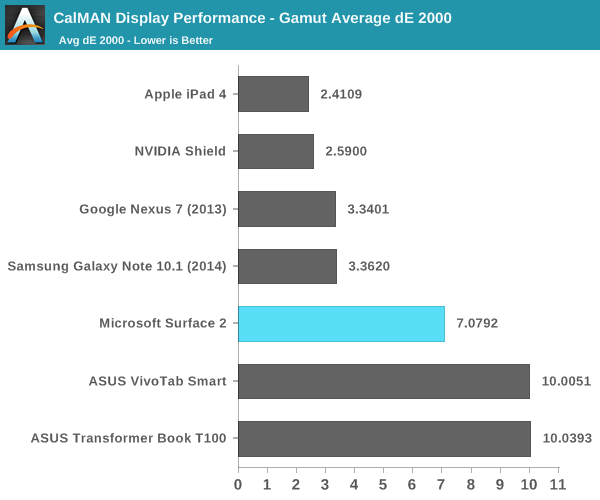
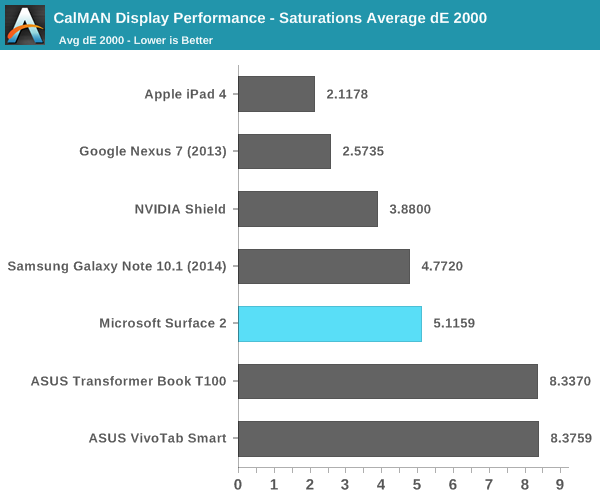
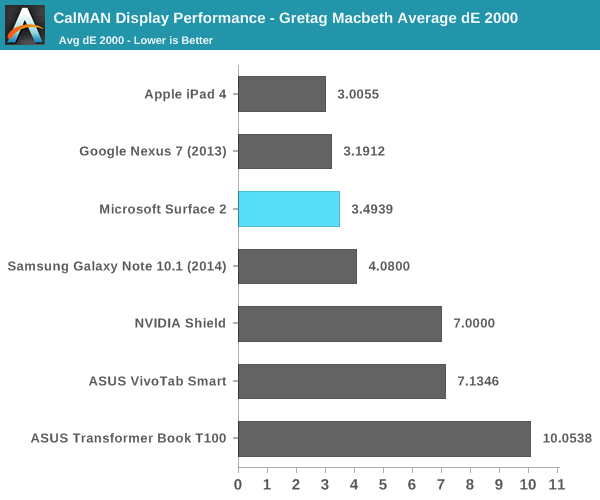
Grayscale accuracy is actually quite good, as is Surface 2’s performance in our GMB pattern test. Measuring accuracy while we scale color saturation however has the Surface 2’s display falling short of the competition, and our basic gamut test doesn’t come out very strongly either.
Microsoft continues to be proud of the fact that its Surface 2 (and Pro 2) displays are laminated to their cover glass to help reduce reflections. In practice I can say that this helps improve the overall experience while using the devices.
Overall display performance isn’t bad at all, and it’s an improvement over what Microsoft shipped last year, but it could definitely be better. Google set the new bar with the $229 2013 Nexus 7’s display and all competitors really have to meet it at this point.


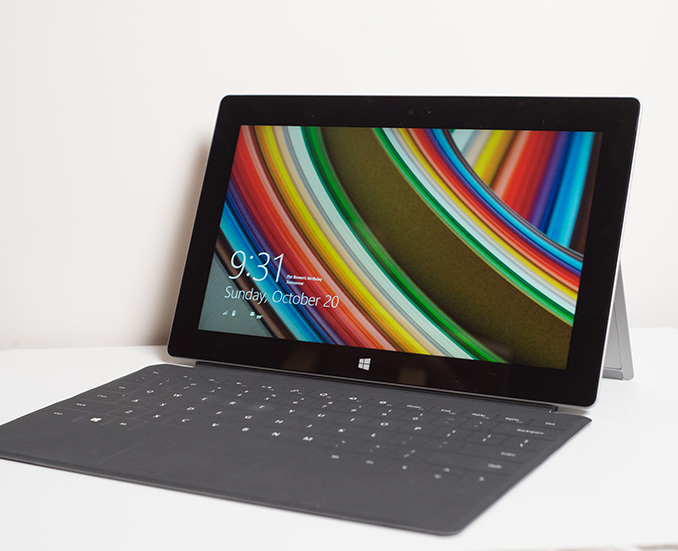








139 Comments
View All Comments
Braumin - Monday, October 21, 2013 - link
http://windows.microsoft.com/en-CA/windows-8/conne...Does that not still work? It worked in 8 I haven't tried in 8.1 but not sure why they would remove it.
Memristor - Monday, October 21, 2013 - link
Of course it works. I have set up several Win8.1 systems and it works the same, actually much better integrated now. My only problem is that you can't see what skydrive is doing in the background. In 8.0 you had a status message that showed the progress of file sync, in 8.1 is only a visual marker in folder view that shows a file sync is in process, but not how much is completed.noeldillabough - Monday, October 21, 2013 - link
So I gave it a try from home, logged in as local account and sure enough it says this: "You're almost done. Your existing account will now be changed to a Microsoft account. All of your files on this PC will remain in place.Gonna cancel and create another account and "convert" it and see what happens.
mooshuc - Monday, October 21, 2013 - link
appears that you can see sync status by launching the skydrive modern app.althaz - Tuesday, October 22, 2013 - link
I just agreed with you on this...but I just realised no matter what cloud storage solution you use you need to login to an external service.skiboysteve - Monday, October 21, 2013 - link
Agreed. Why buy a MS product and then talk about google service integration? That's like buying a nexus and expecting to log in with your Microsoft account. It makes no sense.just use the MS services when you use an MS device. You will find them in many ways second to none.
Ancillas - Monday, October 21, 2013 - link
That's like saying I shouldn't use Google services over iCloud if I own an iOS device. I don't like tying my data to my hardware because it limits my ability to change platforms. Hardware that limits my ability to interact with third-party cloud providers is a deal-breaker.Silellak - Monday, October 21, 2013 - link
Exactly. I use Google's services because it's the best cross-platform choice for my daily use cases. I don't intend to change ecosystems just so I can use a single device better.Braumin - Monday, October 21, 2013 - link
It's a fair point, but cross-platform and Google are not the same thing. Google is the one that refuses to make any apps for Windows 8 or Windows Phone.Arguably Microsoft now how the most cross platform cloud services now.
But if you are going to use the Surface and review it, really it should be with all of the MS Services so you can get the full experience. The new SkyDrive integration is really quite excellent and seamless, and it's nice how everything will sync across devices like your background, installed apps, layout, etc.
paulbram - Monday, October 21, 2013 - link
But is Google's ecosystem really the best cross-platform choice? The way I see it is everything that MS has is available on Windows/iOS/Android. EAS just works everywhere. SkyDrive is everywhere. There are Outlook apps as well if you don't want to use the built in stuff. Sure, the full Office is only on Windows but Office web access is available everywhere and that is in my opinion as good if not better than Google Docs.